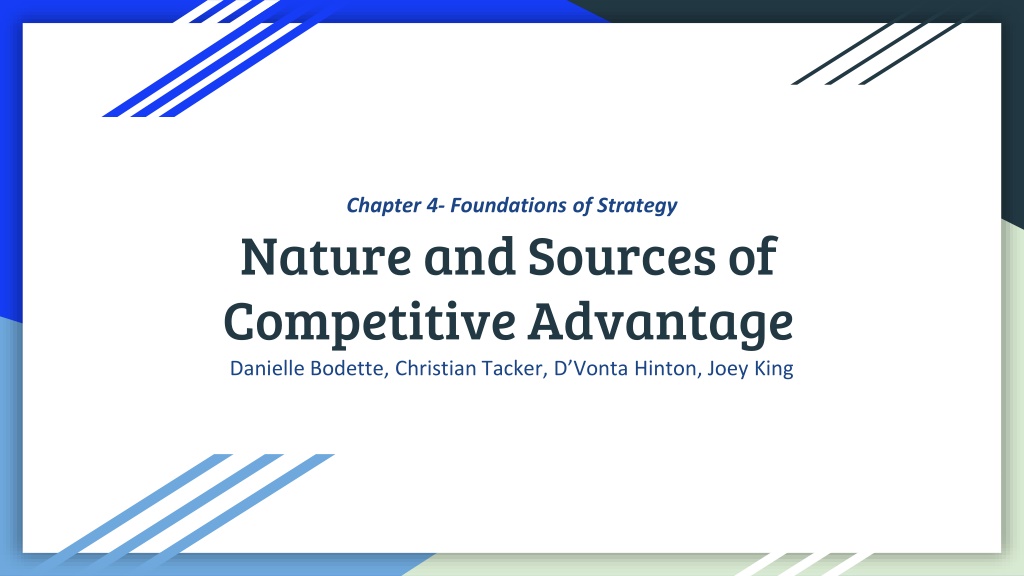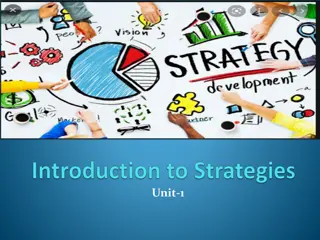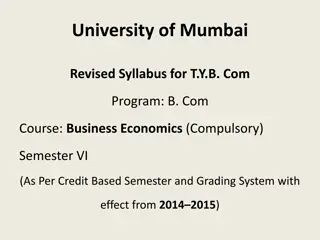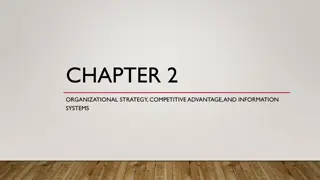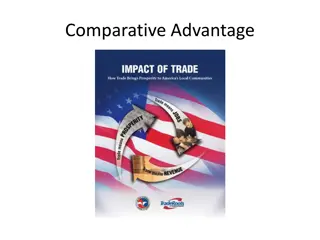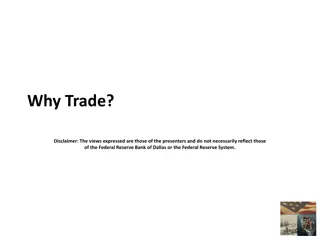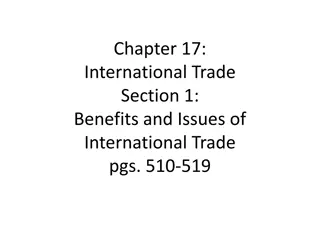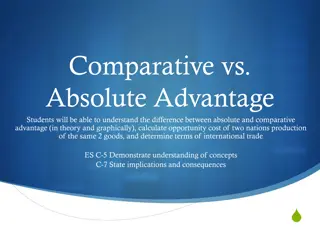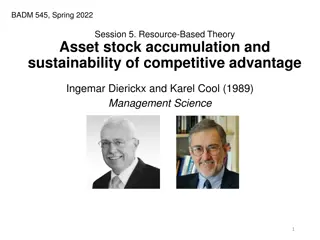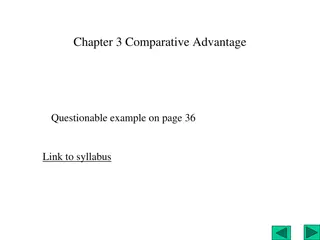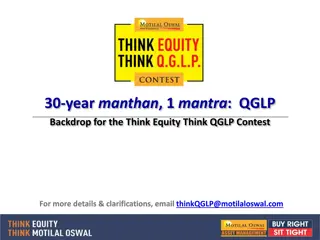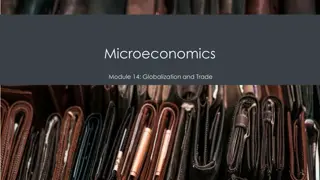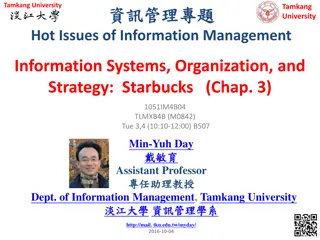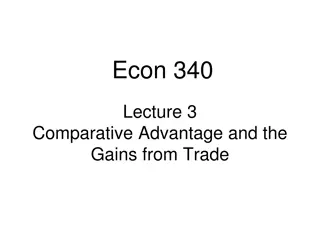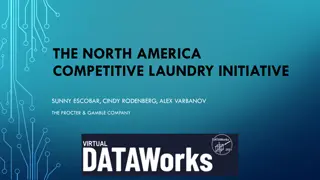Understanding Competitive Advantage in Business Strategy
Exploring the foundations of strategy, this content delves into the nature and sources of competitive advantage. Using Singapore Airlines as a case study, it discusses the importance of establishing a position of competitive advantage, strategies for achieving this, and the challenges faced in a competitive market. The concept of competitive advantage is analyzed in depth, highlighting how external and internal changes can create opportunities for firms to gain a competitive edge.
Download Presentation

Please find below an Image/Link to download the presentation.
The content on the website is provided AS IS for your information and personal use only. It may not be sold, licensed, or shared on other websites without obtaining consent from the author. Download presentation by click this link. If you encounter any issues during the download, it is possible that the publisher has removed the file from their server.
E N D
Presentation Transcript
Chapter 4- Foundations of Strategy Nature and Sources of Competitive Advantage Danielle Bodette, Christian Tacker, D Vonta Hinton, Joey King
Quick Review ! A firm can earn superior profits either by locating in an attractive industry or by establishing a competitive advantage over its rivals. ! The primary goal of a strategy is to establish a position of competitive advantage for the firm. ! Analyzed external sources of competitive advantage ! Analyzed internal sources of competitive advantage
OPENING CASE -SINGAPORE AIRLINES 4 decades of high-quality air travel experience reputation Most Awarded Airline and one of the World s Most Admired Companies Customer service AND cost-effective HISTORY Severed ties with Malaysia Airlines in 1970s Partially owned by the Singapore Government Operationally free from intervention
SINGAPORE AIRLINES CONTINUED... STRATEGY CHALLENGES Young fleet Focus on cutting costs in any way possible! Dominates business class market, sensitive to economy Planes Modern & Efficient Planes STRATEGY Competition in premium air travel Differentiation AND Cost Saving Attractive reputation People Scoot and its potential dangers to parent company Extensive Training
WHAT IS COMPETITIVE ADVANTAGE? When two or more firms compete within the same market, one firm possesses a competitive advantage over its rivals when it has the potential to earn a persistently higher rate of profit Recognizable when we see Walmart: discount retailing in the United States Tesla: automobile research and development, self-driving cars, and supercharger network Apple: iPhones, Apple Watch, the Apple ecosystem External and internal changes can create short-term opportunities for creating an advantage!
EXTERNAL SOURCES OF CHANGE How does competitive advantage emerge? External sources: Changing customer demand Changing prices Technological Change Some firms faster and more effective in exploiting change Resource variety among firms means differential impact
INTERNAL SOURCES OF CHANGE: Competitive Advantage From Innovation Innovation creates competitive advantage for the innovator while undermining the competition. Strategic innovation can be more useful than product innovation - finding new ways to do business. Strategic Innovation: Creates value for customers from novel products, experiences, or modes of delivery. (Ex. Amazon delivery)
Examples of Strategic Innovation: Southwest Airlines - No frills airlines, uses one type of plane, has flexible working methods, and is consistently profitable by offering low prices. Nike - Business model redesigned the shoe industry value chain by outsourcing manufacturing, concentrating upon design, marketing, logistics, and retailers. SixDegrees.com - launched in 1997, pioneered web based social networking, pioneered the way for Myspace and Facebook.
New Customer Segments & New Sources of Competitive Advantage New Customer Segments: Creating new customer segments for existing product concepts can open new market spaces. Examples: Apple Computer, VCR, Nintendo Wii. New Sources of Competitive Advantage Most Blue Ocean Strategies do not launch whole new industries but introduce ways to increase customer value.
SUSTAINING COMPETITIVE ADVANTAGE Competitive Advantage gets eroded by competition. How fast it is eroded depends on the speed that competition can imitate or innovate. Imitation is the most direct form of competition. To sustain competitive advantage, barriers to imitation must exist. Isolating Mechanisms - Barriers that protect a firm s profits from being driven down by competitors. To identify Isolating Mechanisms, one must examine competitive imitation and understand the four conditions of imitation.
Four Conditions of Imitation 1) Identification: The firm must be able to identify that a rival possesses a competitive advantage. 2) Incentive: Having identified competitions competitive advantage (shown by above average profitability), the firm must believe they can earn superior returns by imitation. 3) Diagnosis: The firm must be able to diagnose the features of its rival s strategy that give rise to the competitive advantage. 4) Resource Acquisition: The firm must be able to acquire through transfer or replication the resources and capabilities necessary for imitating the strategy of the advantaged firm.
Deterrence of Imitation Competition can be avoided by undermining incentive for imitation If a firm can persuade rivals that imitation will not be profitable it can avoid competitive challenges. Example. NutraSweet s aggressive price war against the Holland Sweetener Company deterred would-be entrants. Preemption, or occupying existing and potential strategic niches to reduce the range of investment opportunities, can take any forms.
Preemption of Imitation 1) Proliferation of product varieties by a market leader can leave new entrants and smaller rivals with few opportunities for establishing a market niche. (Ex. The 6 leading suppliers of cereal released 80 new brands into the US market between 1950-1972) 2) Large investments in production capacity ahead of the growth of market demand also preempt market opportunities for rivals. (Ex. Monsanto heavily invested in plants for producing NutraSweet, deterring new entrants) 3) Patent proliferation can protect technology-based advantage by limiting competitors technical opportunities. (Ex. 1974 Xerox had over 2,000 patents, most of which were not used, to keep competitors from using their ideas/technological advancements)
DIagnosing Competitive Advantage: Causal Ambiguity & Uncertain Imitability If a firm is to imitate the competitive advantage of another, it must understand the basis of their rival s success. It is difficult to link the superior performance to the strategic decisions that links to the performance. This causes Causal Ambiguity, which is when a firm has multidimensional competitive advantages, making it difficult for competitors to determine what causes the success. The outcome of Causal Ambiguity is Uncertain Imitability; where there is ambiguity for the rivals success, that the outcomes of success are uncertain if the firm were to try to imitate the rival.
Acquiring Resources and Capabilities Firms can acquire resources by buying or building them. Sustained competitive advantage depends on the time it takes rival to gather the resources needed to mount a competitive advantage. Limitation barriers are; Transferability/replicability of resources, and the capabilities of those resources. Key issue for imitators is the extent to which First-Mover Advantage exists. First-Mover Advantage is when the initial occupant of a strategic position or niche gains access to resources and capabilities that a follower cannot match. By being the first, the firm is able to preempt the best resources or use their early entry to build superior resources or and capabilities.
Types of Competitive Advantage: *A firm can achieve a higher rate of profit (potential profit) in one of two ways. It can either: *Supply an identical product or service at a lower cost or: *Supply a product or service that is differentiated in such a way that the customer is willing to pay a price premium that exceeds the additional cost of the differentiation.
Cost Advantage and Differentiation Advantage *The goal with cost advantage is to become the cost leader within the industry. The firm must find and exploit all sources of cost advantage. (Outsourcing, Overhead, Efficient Plants) *Differentiation is achieved when it provides something unique that is valuable to buyers beyond a low price. (Emphasis on branding, ads, new product development.)
Strategy and Cost Advantage *Cost Drivers consist of seven principal determinants of a firm s unit costs relative to it s competitors. (Vary by industry) 1. Economies of Scale (Specializations, input-output relations) 2. Economies of Learning (Increased individual skills) 3. Production Techniques (Process inovation) 4. Product Design (Standardization) 5. Input Costs (Low cost inputs, Location) 6. Capacity Utilization (Ratio of fixed to variable costs) 7. Residual Efficiency (Organizational slack, manager efficiency)
The Drivers of Cost Advantage *We can analyse a firm s cost position relative to it s competitors and diagnose the sources of inefficiency and make recommendations to improve cost efficiency. Starting with finding: the relative importance of each activity with respect to total costs, comparative efficiency of cost drivers, how costs in one activity affect another driver, and deciding what to outsource.
Principle Stages of Value Chain Analysis for Cost Advantage To analyse a firms cost position, we need to look at individual activities with 6 stages. Break down the firm into separate activities. Establish the relative importance of different activities in the total cost of the product (focus on the activities that are the major source of cost. Compare cost by activity. (see what activities are efficient and not efficient then compare them to competition. Identify the cost drivers Identify Linkages Identify opportunities for reducing costs. (look for outsourcing)
Principle stages of value chain analysis for differentiation advantage. This involves 4 stages - 1.Construct a value chain for the firm and the customer- Draw separate values chains for each of the main categories for customers. 2..Identify the drivers of uniqueness in each activity Examining each activity in the firm s values chain and identifying the variables and actions through which the firm can achieve relations to its competitors offerings. 3.Select the most promising differentiation variables for the firm-Which one should be the primary basis for the firm s differentiation strategy. 4.Locate linkages between the values chain of the firm and that of the buyer-The objective of the differentiation is to yield a price premium for the firm. This requires the firm differentiation to create a value for the customer. Creating value for customer requires either the firm lowers customers cost or that customers own product facilitated is differentiation is facilitated
Porters generic strategies and begin stuck in the middle Porter views cost leadership and differentiation mutually exclusive strategies A firm that considers both is stuck in the middle
